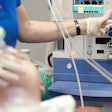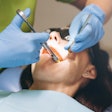
I still remember the very first day of learning dental anesthesia and injections in dental hygiene school. Do you remember that day as well?
Even though it was more than 16 years ago, I vividly remember walking into the clinic that day with my white long coat and bright white clinic shoes, toting a container full of everything you would need to give the best possible injection. My assigned clinic partner that day, Kris, was very nervous about the procedure, both giving an injection and getting numb from a student that has never done something like this before. She was the first person up in my group, and that day we were learning the MSA injection (a low key injection that, really, can you get wrong?) Welp, turns out something can be tricky about it. She was so nervous to insert the needle at all that she ended up pulling out of the tissue then pushing the local anesthetic liquid out of the syringe as fast as she could to get it over with, and I ended up with a mouth full of lidocaine. Even though the taste was awful, it was a great and funny experience to look back on now that it is over.
But, imagine my surprise after graduating and learning about a new (to me) injection — the Anterior Middle Superior Alveolar (ASMA) injection. If I had learned this injection in school, I may not have had this experience with a MSA injection!
Now, this injection is a palatal injection, so you do have to use a bit of pressure when dispensing the local anesthetic like my friend used, but can work wonders for numbing several areas at once for your patients. With just this one injection, you can numb several areas on the maxilla — pulpal tissue from the midline through the premolars on the side you are placing the injection, the hard palate, and palatal gingiva, as well as the facial periodontium. Due to the porous nature of the palatal tissue and bone, anesthesia is able to penetrate the dental plexus of the ASA and MSA nerves. It really is one injection in the place of several local infiltrations or doing the MSA, ASA, GP, and Nasopalatine blocks.
Placement, landmarks, and application
To perform this injection, you’ll want to place your needle at the apices of the premolars on the palatal side you’re working on. The landmark location is the midportion of the anterior palate, approximately halfway along the “line” connecting the median palatal raphe and the palatal free gingival margin between the premolars. Once the landmark has been located, the needle only needs to be placed into the tissue 2 to 3 millimeters before performing an aspiration and deposition.
Since it is placing solution into the palate, application is slow (only 0.5 mL per minute) to help prevent ulcers or issues with healing after the injection is placed. Unfortunately, this can cause practitioner fatigue due to the time and pressure it takes to place this injection.
To see the injection in action and see the landmarks on a patient, check out this video from Hygiene Edge.
Advantages of the ASMA injection
Precision and targeted anesthesia. The ASMA injection targets specific nerve branches in the maxillary anterior region, ensuring precise and effective anesthesia for procedures involving maxillary teeth.
Fewer injections needed in treatment. Instead of completing 5 maxillary injections, your number of injections decreases to two (just the PSA and ASMA) to achieve full quadrant anesthesia.
Smile line intact. Since we are not placing local anesthesia in the anterior soft tissue, this injection technique will not affect the smile line and soft tissues of the lips. This is a great option for patients if you’re doing anterior cosmetic procedures or are requesting not having the “sleepy” feeling in their lips after the procedure.
Less local anesthesia is needed. Since this injection hits high on the nerve branch, less local anesthesia is needed to numb the entire quadrant. This is a great option for patients who need to fit in the cardiac doses of local anesthesia but need several areas in the mouth numb for treatment in one day.
Disadvantages of the ASMA injection
Not recommended for patients who have a hard time healing. With any palatal injection, healing can be trickier due to the pressure for placement and solution in a tight area. This injection should be avoided for patients who don’t heal well or have a suppressed immune system.
Time. With a palatal injection, the deposition time is longer due to the tight tissues. The rate of deposition should be 4 to 5 minutes, depending how much local anesthesia you are using. This has a high chance of practitioner hand fatigue due to the time needed for placement.
Traditional topical local anesthetics usually don't help. Since the tissue on the palate is keratinized, traditional topicals like benzocaine placed before most injections really won’t help that much. Instead, pressure anesthesia will be required if a topical is requested.
Practitioner fatigue. Since this is a slow injection in a tight space, there is constant pressure needed during application. This can add to hand fatigue in a dentist or dental hygienist, possibly affecting the physical abilities during treatment.
Next time you have a patient in your operatory that needs a full quadrant of local anesthesia on the maxillary, using the ASMA injection might just be the answer for you to help.
Have you tried this injection before? What was your experience? Let us know in the comments section below.
Melia Lewis a proud clinical dental hygienist in Utah, as well as current adjunct faculty at Colorado Northwestern Community College in the bachelor completion program. She grew up in the dental world and has always had a love of science and the human body. She is cofounder of Hygiene Edge, an online education platform full of helpful tips and tricks to make dental professionals' lives easier in their clinical day and to help inspire them to be their best. When she’s not talking about dentistry, she’s planning her next trip either out of the country or to a National Park with her husband and two daughters. For any questions, please reach out to her at [email protected] or on Instagram @hygieneedge and @meliardh.
The comments and observations expressed herein do not necessarily reflect the opinions of DrBicuspid.com, nor should they be construed as an endorsement or admonishment of any particular idea, vendor, or organization.



















